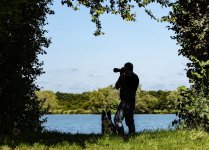In today's world, where urban landscapes dominate and technology rules, it is easy to become disconnected from the wonders of the natural world. Animal photography serves as a powerful bridge, allowing us to reconnect with nature and appreciate the diverse and captivating creatures that inhabit our planet. In this blog, we will explore the art of animal photography, from the technical aspects to the profound impact it can have on both the photographer and the viewer.

c. Composition and Perspective: Animal photography offers a myriad of composition possibilities. Experimenting with various angles, framing techniques, and perspectives can add depth and visual interest to the photographs. Close-up shots emphasize intricate details, while wide-angle shots showcase animals in their environments, providing a broader narrative.
- The Magic of Animal Photography: Animal photography goes beyond capturing a mere image; it encapsulates the beauty, grace, and raw emotion of the animal kingdom. Photographers have the unique ability to freeze fleeting moments, revealing aspects of an animal's life that might otherwise go unnoticed. The mesmerizing eyes of a predator, the intricate patterns on a butterfly's wings, or the playful antics of a group of monkeys – these are all moments that animal photographers strive to capture.
- Technical Considerations: a. Equipment: A successful animal photographer relies on a combination of skill, patience, and appropriate gear. A high-quality DSLR or mirrorless camera, versatile lenses, and fast autofocus capabilities are essential tools in capturing sharp and detailed images of animals in their natural habitats. Additionally, telephoto lenses allow photographers to maintain a respectful distance while still capturing intimate shots.
c. Composition and Perspective: Animal photography offers a myriad of composition possibilities. Experimenting with various angles, framing techniques, and perspectives can add depth and visual interest to the photographs. Close-up shots emphasize intricate details, while wide-angle shots showcase animals in their environments, providing a broader narrative.
- Ethical Considerations: a. Respect for Wildlife: Ethical animal photography places the well-being of the subject above all else. It is crucial to maintain a safe distance and avoid causing distress or disrupting natural behavior. Respecting wildlife and their habitats helps preserve the authenticity and integrity of the images.
- Connecting with Nature: For photographers, the art of animal photography is not just about capturing breathtaking images. It is a deeply personal and transformative experience that connects them with nature on a profound level. Spending time observing and photographing animals fosters a sense of appreciation, awe, and understanding of the natural world, instilling a desire to protect it for future generations.
- Showcasing Animal Photography: The digital age has revolutionized the way animal photography is shared and appreciated. Platforms like social media, websites, and online galleries provide photographers with avenues to showcase their work, reach wider audiences, and engage with fellow enthusiasts. This virtual community fosters collaboration, feedback, and inspiration, further fueling the passion for animal photography.
